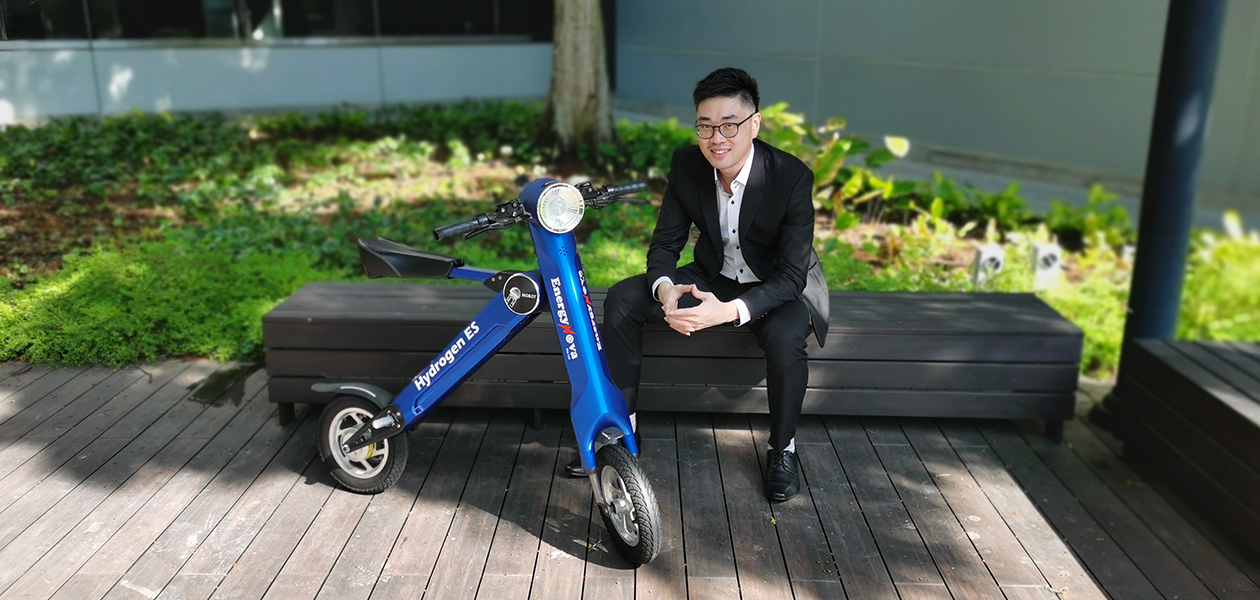Fuelling the future with open innovation
Cleaner energy sources are needed now more than ever before, and Adec Thng of EnergyNova is confident that hydrogen fuel can provide for society's energy needs.
As far as climate change is concerned, one greenhouse gas has a particularly bad rap—carbon dioxide. Produced in vast quantities from the burning of fossil fuels and persisting in the atmosphere for years, this odourless, invisible compound has been blamed for global warming, the melting of the polar ice caps, rising ocean levels and unpredictable weather.
The United Nations has warned that we have only 12 years to change our ways to avoid a climate catastrophe, but until human society overcomes its addiction to “dirty” carbon-based energy sources, the upward tick of global temperature looks set to continue. Alternative, cleaner fuels are urgently needed, and some deep tech entrepreneurs are looking to the first element on the periodic table to provide it—hydrogen.
“Hydrogen is abundant in the form of water, contains huge energy and produces no carbon emissions when burned,” said Adec Thng, Chief Operating Officer of EnergyNova. Founded in 2016, the Singapore-based energy company designs and manufactures compact, lightweight and on-demand hydrogen generators that can be used to power energy intensive applications.
In an interview with IPI, Thng shares how embracing open innovation has led to his company’s rapid growth in the past two years.
1. What is the core competency of your company?
Our technology is all about making hydrogen safe and easy to use for everyone. However, there is one major hurdle when it comes to using hydrogen: hydrogen gas is usually stored in high pressure tanks at 700 bar of pressure, almost equivalent to the pressure exerted by almost 1,300 adult elephants! Furthermore, hydrogen is flammable, so we are sure no one wants to be anywhere near these tanks. Hence, hydrogen fuel is still not commonly used.
To solve the problem, EnergyNova developed a unique solid powder formula that can produce hydrogen. The chemistry is simple: we mix our solid powder with water to generate hydrogen on demand, in a controlled manner. The hydrogen is immediately consumed by a fuel cell to generate electricity, which means that the amount of hydrogen at any point in time is minimal. Because of this, we can achieve very low operating pressure in our hydrogen fuel cells. While the chemistry is simple, the system design is not. This is why we have 11 patents, of which six have been granted.
2. Was there a turning point in your company's history that convinced you that open innovation was the right way to grow?
There is a Chinese saying—“四两拨千斤”—which translates to “leveraging on something bigger to achieve the force of a ton using just four ounces of strength”. We are a start-up and we are always limited by resources.
From day one, we strongly believe that by “hunting in a pack”, we will achieve much more in a shorter time than by working alone. Hence, adopting open innovation has always been our mantra, especially at our current stage of growth and expansion. We are happy that it has worked out very well for us so far.
3. How has open innovation benefitted your company so far?
We have been in operations for two years now, and within that short span of time, we have made many friends and struck up many long-term partnerships along the way. Our first partner was Temasek Polytechnic, an institute of higher learning in Singapore, which we were introduced to by IPI.
We discovered great synergy between a technology developed at Temasek Polytechnic and our own. Temasek Polytechnic was also kind enough to accept us into their community and allowed us to conduct our R&D on their premises. In the end, we managed to license their technology and develop a long-term working relationship with them. In this regard, IPI played a pivotal role in EnergyNova’s emergence and we are utmost grateful to IPI for their help.
We have since teamed up with Singapore-based companies MOBOT and Duralite Power to develop the world’s first electric scooter powered using hydrogen fuel. As a result, we were invited to pitch in 2018 to Prince Andrew, Duke of York, and an esteemed audience at Saint James’ Palace. We are also currently working with a local university to develop a drone that can outlast all existing battery-powered drones in the market by at least three-fold in terms of flight time.
4. How do you encourage a culture of open innovation in your company?
We have the policy of “the door is always open”, and it applies to all our employees. We work together as a team to solve problems. While the main decisions will still be made by the co-founders, all our employees are encouraged to speak up. We believe that no one has the answers to all questions, not even the co-founders.
Once an employee understands that the co-founders are willing to listen, they will feel empowered in their work and more willing to contribute, while having a receptive mindset towards open innovation.
5. What are some lessons that you have learnt in the process of engaging in open innovation?
The key to open innovation is for all partners to strive towards a win-win outcome from the partnership. The partnership will only thrive if all parties are able to benefit from it. It is also important that expectations are set right from the beginning. This will prevent any miscommunication during the engagement, which could lead to undesirable outcomes.

